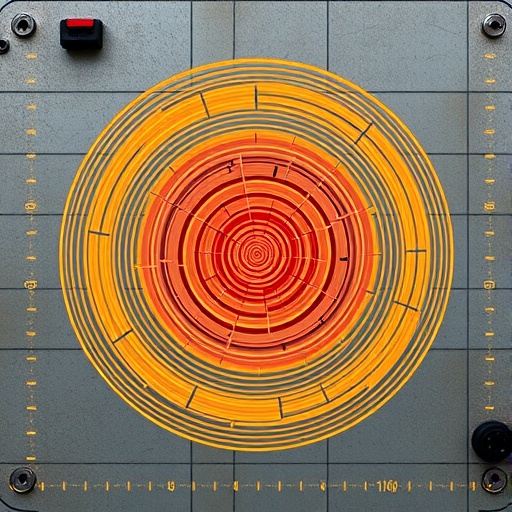
In the rapidly evolving field of structural health monitoring, an innovative breakthrough is spearheading advancements in the detection of hidden defects within steel infrastructures. Researchers led by Trung L.Q., Khuong N.D., and Dung T.T.H. have developed a flexible eddy current array measurement system designed specifically for crack detection in weld zones of steel structures. This cutting-edge technology promises not only to redefine inspection accuracy but also to significantly enhance safety and reliability in critical engineering sectors such as construction, transportation, and energy.
The integrity of steel welds remains one of the most vulnerable points within large-scale structures, often acting as the origin for cracks that can lead to catastrophic failures if left undetected. Conventional non-destructive testing (NDT) techniques, while valuable, face limitations in flexibility, resolution, and efficiency, particularly when confronted with complex geometries or constrained access environments. The advent of a flexible eddy current (EC) array system offers a game-changing solution by adapting to these challenges with unprecedented dexterity and detection capability.
Central to this innovation is the marriage of flexibility and multi-element sensing arrays, which collectively form a measurement system capable of conforming to the often irregular and curved surfaces typical of welded steel components. The technology leverages the fundamental principles of eddy current testing, wherein alternating electromagnetic fields induce localized currents on conductive surfaces. Flaws such as cracks disturb these circulating currents, allowing for their identification through variations in sensor outputs. The flexible design ensures sustained contact and consistent lift-off distance, crucial factors for reliable data acquisition.
.adsslot_LfUjV913Qr{width:728px !important;height:90px !important;}
@media(max-width:1199px){ .adsslot_LfUjV913Qr{width:468px !important;height:60px !important;}
}
@media(max-width:767px){ .adsslot_LfUjV913Qr{width:320px !important;height:50px !important;}
}
ADVERTISEMENT
The multi-element array offers significant improvements over single-coil probes by simultaneously scanning extensive surface regions and providing high spatial resolution. This multi-sensor architecture facilitates advanced signal processing techniques, including phase and amplitude analysis, enabling subtle crack features to be discerned with high sensitivity. Beyond merely locating surface cracks, the system demonstrates potential for characterizing crack depth and orientation, attributes vital for informed maintenance decisions.
From an implementation perspective, the research team has employed state-of-the-art materials and circuit integration methods to fabricate the flexible sensor arrays. These arrays are embedded within adaptable substrates, maintaining electrical performance while conforming to the demanding contours of weld zones. The integration with portable data acquisition units and real-time imaging software further empowers inspectors to perform rapid, on-site evaluations without the need for expensive or bulky equipment.
One of the compelling advantages of this flexible eddy current array system lies in its ability to function effectively despite environmental noise and surface conditions that traditionally hamper other NDT techniques. Weld zones often exhibit roughness, variable geometry, and residual stresses, all of which can degrade detection accuracy. The adaptive nature of the flexible array mitigates these issues by maintaining optimal sensor positioning and allowing calibrations that compensate for surface irregularities.
As structures age and the global infrastructure network expands, the demand for reliable and efficient inspection tools becomes increasingly critical. Frequent structural health assessments can prevent disastrous failures, extend service life, and reduce maintenance costs. The flexible eddy current array system, by offering enhanced crack detection capabilities, aligns perfectly with these operational objectives, potentially serving as a cornerstone technology in future asset management frameworks.
Another dimension of significance is the potential automation of inspections enabled by this technology. The array’s design facilitates integration with robotic platforms or drones, which can perform inspections in hazardous or hard-to-reach locations. This capability not only improves safety by minimizing human exposure but also increases inspection frequency and coverage, delivering richer data sets for predictive maintenance.
Moreover, the system exhibits versatility, applicable across various steel-based industries beyond traditional civil engineering. For instance, it could be instrumental in monitoring weld integrity in shipbuilding, aerospace structures, and power generation facilities, where early crack detection is paramount to operational safety and regulatory compliance. The scalable design ensures that arrays can be tailored to different inspection scopes, from small components to large-scale industrial installations.
The researchers also highlight the prospects for coupling this technology with advanced machine learning algorithms, enabling automated interpretation of eddy current signals and classification of crack types. Such a symbiosis could transform raw detection data into actionable insights, guiding maintenance teams through complex decision-making processes with higher confidence and efficiency.
In the experimental evaluations, the team demonstrated the system’s proficiency in identifying cracks of varying dimensions and under simulated operational conditions. The high correlation between detected signals and known defect parameters underlines the system’s accuracy and reproducibility. These results reinforce the assertion that flexible eddy current arrays could soon become the gold standard for weld zone inspections.
The development process also accounted for practical field deployment considerations, such as durability, temperature tolerance, and ease of handling. The flexible substrates perform robustly in diverse environmental conditions, ensuring consistent performance during extended inspection campaigns. User-centric design principles underpin the entire system, ensuring rapid training and adoption by inspection personnel.
This breakthrough arrives at a time when conventional inspection methods are straining under the weight of aging infrastructures worldwide. The ability to rapidly detect and characterize cracks without dismantling components or interrupting operations introduces notable time and cost efficiencies. Consequently, the adoption of flexible eddy current arrays in industrial inspection protocols could lead to safer, more resilient infrastructure systems on a global scale.
In conclusion, the flexible eddy current array measurement system represents a paradigm shift in non-destructive testing of steel welds. By marrying flexibility, high-resolution sensing, and advanced signal processing, this technology delivers precise crack detection capabilities that overcome longstanding challenges in the field. Ongoing research and development efforts are anticipated to refine the system further, with broader deployment poised to strengthen structural safety and operational reliability across myriad applications.
As the global engineering community eagerly watches, this pioneering work stands as a testament to the power of innovative sensor design, melding fundamental physics with practical engineering demands to safeguard the infrastructure upon which modern society depends.
Subject of Research: Flexible eddy current array system for crack detection in weld zones of steel structures.
Article Title: Flexible eddy current array measurement system for crack detection in weld zones of steel structures.
Article References:
Trung, L.Q., Khuong, N.D., Dung, T.T.H. et al. Flexible eddy current array measurement system for crack detection in weld zones of steel structures.
Commun Eng 4, 132 (2025). https://doi.org/10.1038/s44172-025-00472-9
Image Credits: AI Generated
Tags: advanced sensing technologies for steelcrack detection in steel structurescutting-edge engineering solutionsdetecting hidden defects in steelflexible eddy current arraysflexible inspection methods for complex geometriesinspection accuracy in constructionnon-destructive testing innovationsreliability in infrastructure monitoringsafety improvements in engineeringstructural health monitoring technologyweld zone inspection techniques






